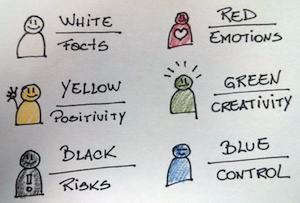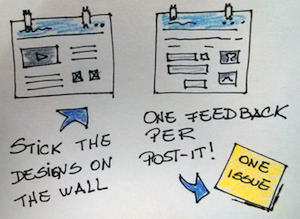Disclaimer: The statements and opinions expressed in this article are those of the author(s) and do not necessarily reflect the positions of Thoughtworks.

A design critique session can be tough. Some people don’t feel comfortable enough to give an honest opinion and limit themselves to giving positive feedback. Others will only observe the negatives. And most folks base their critique on their own biased aesthetic viewpoint rather than focusing on the purpose of the design (form follows function, remember?). These and a number of other reasons can turn a design critique session into an endless back-and-forth conversation.
Enter Six Thinking Hats….
To keep the group focused on providing feedback based on different views of the same situation minus the conflicts, I’m using a methodology created by Edward DeBono called Six Thinking Hats. It is also known as the Black Hat session, as the black hat is really important to it, as I’ll describe later.
The core of the Six Thinking Hats is to help people to change their own thinking process. When giving feedback we tend to be biased, too positive or too negative and we usually forget to see all aspects of the situation.
To use this method, we divide the group into six different roles, six different “thinking hats”:

The Black hat is special to this process. To create the best design we should have a high level of auto-critique. However, it can be hard to to pinpoint your own gaps when you are the only one thinking through the design. The Black hat will ensure that risks, weakness and critical issues will be taken into consideration in an open and safe environment.
Running the session
This session can be run whenever you feel that user feedback is needed to validate your design ideas to move ahead with development, engage the team in the design process or make decisions, which means - always. The session should be time boxed to 60-90 min. You will need Post-its, pencils, paper hats (or tags) and a printed version of the interfaces that need feedback (put them visibly up on a wall for people to take a close look).
Ideally, and to keep it fun, colorful paper hats can be used to indicate each person’s role during the session. You can also use tags and write the color name on each of them. Distribute the colors, explain what they mean, and give the team 15 minutes to look at the designs. They can provide as much feedback as they want, but limited to one piece of feedback per post-it. Then post their notes around the designs, or you can help them to group the feedback in categories.

Next, everyone is invited to present their feedback to the group. If your group is large, and you have more than one person per role, ask them to pair on their presentations.
At the end of the session you will have tons of feedback from different perspectives and will be able to prioritize issues and define (or confirm) the right path for your design vision on the project.
An extra benefit is to create a collaborative environment where everyone is responsible for the User Experience. A open session like that, with the participation of your team, real users and stakeholders creates a balanced environment that considers the user needs, the business purpose and the right technology to create great products.
Thoughts? What tools and techniques do you use to collect meaningful feedback and generate discussion around design?
Disclaimer: The statements and opinions expressed in this article are those of the author(s) and do not necessarily reflect the positions of Thoughtworks.
